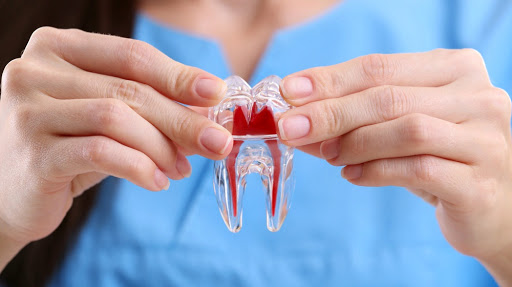Let’s Talk Toothaches: Are You Afraid of Root Canals?

What is a Root Canal?
So many people are afraid of root canals without really understanding them. That’s why we wanted to dedicate this blog to help you understand more about them.
Beneath the hard, outer layer of the tooth’s enamel and dentin is a soft tissue known as the pulp that houses the blood vessels, nerves and connective tissue. The actual root canal is the pulp-filled cavity in the root of a tooth.
However, the procedure of getting a root canal treatment is what is often referred to as a root canal.
A root canal treatment is a procedure used to save the tooth when there is decay, inflammation, infection or a crack in the tooth that affects the nerve in its root, or the pulp, of the tooth. The inside of the tooth is then cleaned and sealed.
Without treatment, the tissue surrounding the tooth will become infected and abscesses may form, the infection can get worse requiring further treatment and sometimes the tooth may actually need to be removed. Remember, the infection is what’s causing the pain. Once the infection has been removed, the pain is gone.
Does it sound scary? Or painful? Only if you’ve never experienced a root canal. That seems to be the main source of fear – not knowing what to expect. So, let’s take the “scary” out of this very common procedure and talk about the facts.
Here are the Top 3 Reasons You Shouldn’t Be Afraid of Root Canals:
Afraid of Root Canals: It May Not Actually Hurt
Root canals have a bad reputation as being a painful procedure. However, most people who have had a root canal, refer to it as a “painless”. Before the procedure, a numbing anesthetic medicine will be injected around the infected tooth, which will feel like a slight sting on your gum. After that, you’ll barely feel a thing.
Related Article: Root Canal Treatment: 5 Common Myths Debunked
Afraid of Root Canals: Your Tooth Will Be Saved
The entire goal of root canal treatment is to save the infected tooth. After this part of the procedure, your dentist will put a crown or filling on the top of the tooth. Once completed, it isn’t even noticeable and with proper dental hygiene, your tooth can last a lifetime. Read more about Getting a Dental Crown Procedure.
Afraid of Root Canals: Your Pain Will Be Gone
Another reason people are afraid of root canals and the treatment is because they’re afraid there will be pain after the root canal. You may have some pain after the procedure, but typically an over-the-counter pain reliever like ibuprofen will help. If you’re at risk for infection, your dentist will prescribe an antibiotic to clear it up. Most people return to their normal routine the very next day.
Read More about What Causes Toothache Pain?
Signs and Symptoms
How will you know if you need a root canal? Most people experience some level of pain or sensitivity to hot or cold when eating or drinking or when putting pressure on the area. You may notice a small, pimple-like bump on the gums near the area of the tooth pain. Others may notice their tooth darkening.
If you’re in a lot of pain, schedule you may need emergency dental care, Read More.
Here are 5 simple steps to follow before or after having your root canal treatment:
Take any antibiotics as prescribed by your dentist.
It is perfectly normal for a tooth that has had root canal therapy (also known as endodontic therapy) to be tender for a short time after the treatment has begun throughout the root canal recovery process.
Relieve any pain with anti-inflammatory medication
When a tooth is infected and requires a root canal, the periodontal fibers that anchor the tooth to the bone are also irritated and stretched from infection around the roots of the tooth. The trauma of the fibers/ligaments being stretched can also be very painful and will need some time to heal. Ibuprofen, either over the counter or a stronger dosage prescribed by your dentist, has an anti-inflammatory action that will provide relief during the healing period. Gentle but thorough cleaning of the tooth and gums around the recently treated area is best for quickest healing and relief of discomfort from irritated gums.
Give the treated tooth some time to settle down and become more comfortable
“Ghost pain” after a tooth has had a root canal can be explained by the fact that nerves in the root of the tooth have been amputated from the major nerve that supplies all of the teeth along its pathway. In much the same way people who have had a limb removed report pain in the missing limb. The “ghost pain” diminishes over time and usually goes away completely. But, remember each situation is unique.
Often an infected tooth has been pushed slightly out of the socket by the infection accumulating at the root tips. The infected tooth is bearing more biting pressure than it can comfortably stand. Even if the tooth has had some reduction of its height taken off by the dentist, it may still be tender for a few days. Grinding your teeth or clenching your jaw muscles (bruxing) contributes to any pain you may be experiencing after your root canal treatment. A night guard or relaxation techniques to keep your teeth slightly apart, can contribute to a more comfortable dental state.
Avoid hard, crunchy or tough foods for several days after a root canal
Staying with softer foods and chewing on the opposite side are helpful suggestions to reduce pain after your root canal treatment. If the tooth does not become less sensitive after a few days, additional adjustment of the traumatic biting pressure may be needed by your dentist.
A tooth that has had a root canal is more brittle. Most of the time a tooth that needs a root canal had a large area of decay or a large old filling, so little of the original healthy tooth structure remains. A full crown to reinforce a more fragile recently-treated tooth is recommended as soon as possible after a root canal has been completed. If the tooth develops a crack or fractures, there can be pain associated with that unwanted occurrence.
Having a crown made for a root canal-treated tooth helps to maintain it, keep it intact, functional, and less likely to develop pain from fracturing
The final step of a root canal is often placing a crown. Often when a tooth needs a root canal, there is extensive decay or a large filling that was placed a long time ago. In order to restore the tooth to full function and lessen further complications such as fracturing, a crown is placed.
If you have a toothache, we can help!
See, now that you know more about symptoms you may be experiencing and the root canal treatment procedure itself, you’re not afraid of root canals and you can schedule your procedure! If you’re experiencing a toothache, please give us a call and schedule your appointment. If you’re in pain, we can find why and fix your tooth. Our main goal when you have a toothache is to get you out of pain as quickly as possible!
Contact us today to schedule your dental appointment and meet with our skilled dentists at one of our three conveniently located dental office locations within the Kansas City area, including Lee’s Summit / Independence, the Country Club Plaza and Downtown Kansas City. The gentle dentists and expert team at Thomas L. Anderson and Associates look forward to working with you to treat your dental emergency, achieve proper oral health and a beautiful smile that will last a lifetime. If you have any questions about your dental insurance benefits, please do not hesitate to contact us. We are happy to review your policy! Please give us a call today to schedule an appointment and become part of our dental family.
